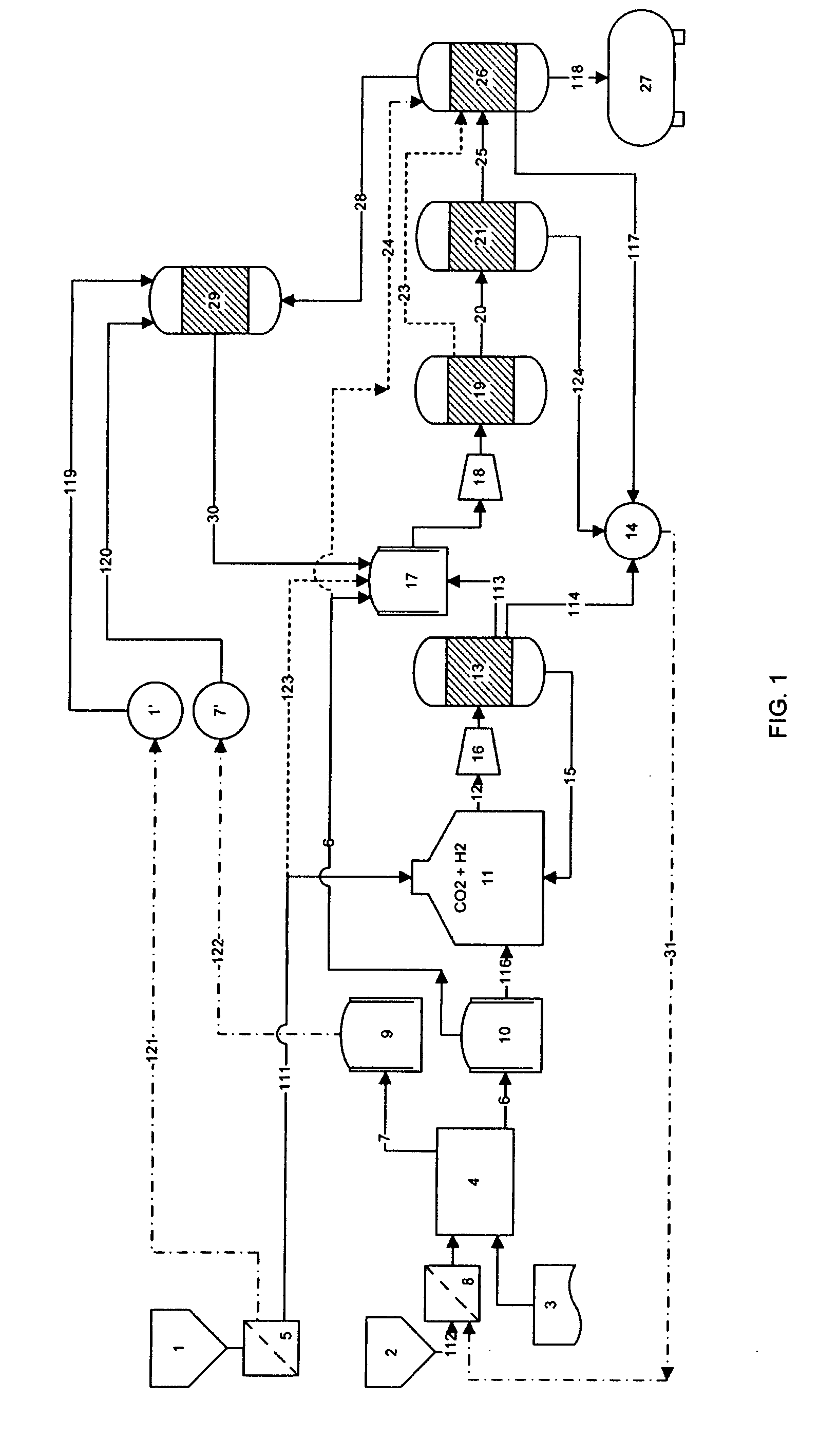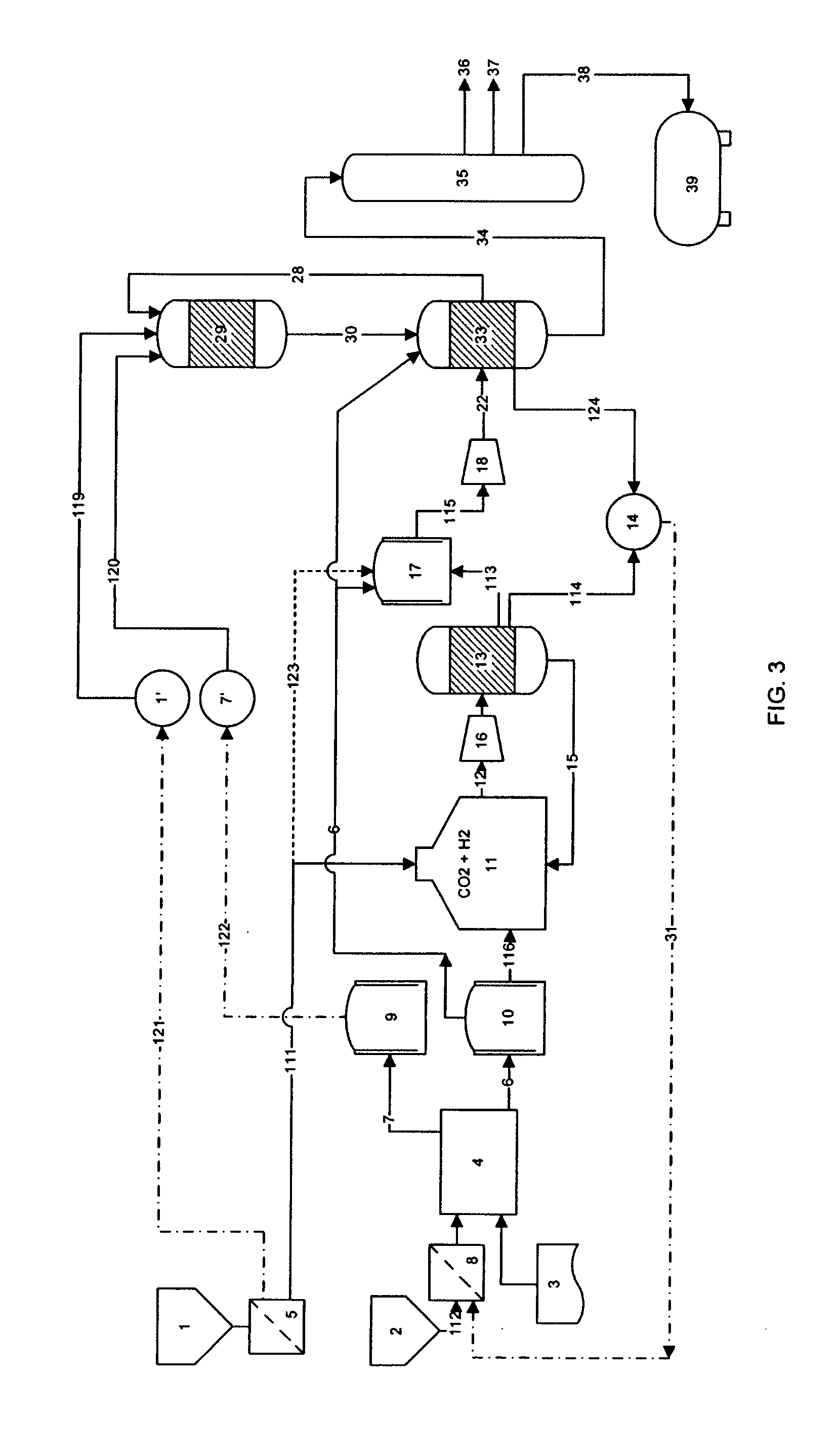Process for producing liquid fuel from carbon dioxide and water
a technology of carbon dioxide and liquid fuel, applied in the field of energy conversion, can solve the problems of high cost, high cost, and high cost of gasoline production, and achieve the effect of reducing and increasing the cost of gasoline production
- Summary
- Abstract
- Description
- Claims
- Application Information
AI Technical Summary
Benefits of technology
Problems solved by technology
Method used
Image
Examples
example 1
Hydrogen Production Using a BAE-Unit of 2328 kW
[0113] Production capacity is 43.6 kgH2 / hr with an conversion efficiency of 80% (water to hydrogen) and an overall energy efficiency of 73% when the compression of hydrogen and oxygen is included.
[0114] The energy efficiency, which is calculated as the higher heating value HHV of hydrogen divided by the electrical energy consumed to produce one kg of hydrogen can advantageously be raised to about 83%.
[0115] This is done by utilizing excess energy from recycling of fuel gas, LPG and other hydrocarbons not suitable for liquid fuel and / or by using steam generated in the heat exchangers used to balance the highly exothermic methanol production, the MTG or the FT reaction for compression of the gases.
example 2
Conversion of H2 and CO2 to Methanol in a Reaction Loop
[0116] H2 and CO2 are supplied at 50 bar pressure and molar ratio of 3:1 (H2 to CO2) to a methanol synth reactor loaded with a Cu / ZnO / Al2O3, Cu / ZrO2 or a CU—Zn—Cr based catalyst, or any other catalyst suitable for the conversion of carbon dioxide and hydrogen to produce methanol and water.
[0117] The reactor is operated at 225° C. and 20% of the input stream reacts to methanol and water in an equal molar ratio. After exiting the reactor, the output stream is cooled by counterflow heat exchange with the input stream. Then the output stream is further cooled so as to condense the reaction products (water and methanol). The condensed products are collected and periodically ejected, while the non-condensed gases are recirculated by a circulation pump and combined with new incoming input stream.
example 3
Conversion of CO2 to CO in an RWGS Reactor
[0118] The RWGS reaction is carried out in a fixed bed tubular reactor charged with 10 w % Cu loaded g-alumina catalyst. The feed is a 1:1 mixture of CO2 and H2 at 400° C. and 5 bar. It has been shown, that under those conditions higher than 95% equilibrium conversion may be achieved on a routine basis. At 400° C. the equilibrium constant for the reaction is about 0.08 which translates to about 27% CO / CO2 ratio at 95% equilibrium conversion.
[0119] The conversion can be run in recycling mode, where exhaust water is condensed and fed back to the electrolyzer unit and the carbon dioxide may be separated by isothermal compression and further cooling or by other suitable methods. The carbon dioxide is then fed back to the RWGS reactor. The remaining carbon monoxide and hydrogen may be fed directly to the syngas blender or alternately the hydrogen may be partly or fully separated from the gas mixture by membrane filtration and fed back to the RW...
PUM
| Property | Measurement | Unit |
|---|---|---|
| molar ratio | aaaaa | aaaaa |
| molar ratio | aaaaa | aaaaa |
| temperature | aaaaa | aaaaa |
Abstract
Description
Claims
Application Information
 Login to View More
Login to View More - R&D
- Intellectual Property
- Life Sciences
- Materials
- Tech Scout
- Unparalleled Data Quality
- Higher Quality Content
- 60% Fewer Hallucinations
Browse by: Latest US Patents, China's latest patents, Technical Efficacy Thesaurus, Application Domain, Technology Topic, Popular Technical Reports.
© 2025 PatSnap. All rights reserved.Legal|Privacy policy|Modern Slavery Act Transparency Statement|Sitemap|About US| Contact US: help@patsnap.com



